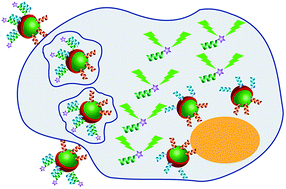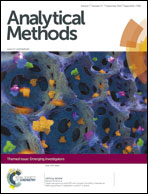Photoluminescent nanosensors for intracellular detection
Abstract
In this manuscript we review the main strategies for detecting changes in intracellular parameters with photoluminescent nanosensors. Examples of the detection of intracellular pH, ion concentration (Na+, Ca2+, Zn2+, Hg2+), reactive oxygen species (ROS, e.g. hydrogen peroxide), variations in temperature, changes in RNA levels and the detection of enzymatic activity are described in detail. The utilisation of nanomaterials such as quantum dots, silicon carbide nanoparticles, nanoscale metal–organic frameworks, upconverting nanoparticles, fluorescent nanoclusters, gold nanoparticles, nanodiamonds, dendrimers and polymeric nanoparticles in bioimaging is highlighted. When compared to molecular probes, nanosensors combine high sensitivity and selectivity with low toxicity, which are crucial parameters for sensing in live cells.

- This article is part of the themed collection: Emerging Investigators

 Please wait while we load your content...
Please wait while we load your content...